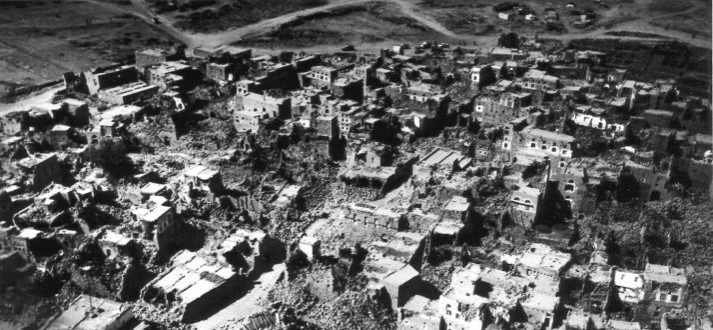The Loess Region is the cradle of China’s civilization. It is also a region particularly vulnerable to earthquake damage because loess soil – rich windblown silt that settled over the millennia to depths of up to 300 meters – disintegrates easily when subjected to seismic activity. Between that vulnerability and China’s high population density, many of the world’s most devastating earthquakes have occurred in China. One such struck in 1556, when Ming Dynasty China was rocked by the deadliest earthquake in human history. Epi-centered in the Wei river basin in modern Shaanxi, the upheaval is estimated to have registered 8 on the Richter scale.
The earth split open with fissures up to 70 feet deep, as the ground suddenly rose up in some place to form new hills, while in other places hills crumbled and subsided into valleys. 97 counties in Shaanxi and surrounding provinces were devastated, as the earthquake destroyed nearly everything within an area more than 500 miles wide, and damage was inflicted as far as 310 miles from the epicenter. Fatalities numbered in the hundreds of thousands, and the injured numbered in the millions.

China’s Shaanxi Province Was and Remains Particularly Vulnerable to Earthquakes
China’s Loess Region is a plateau covering about 250,000 square miles in the upper and middle Yellow River – so named because the loess forming its banks gave it a yellowish tint. The good thing about the region is that the soil that gave it its name and covers the ground in layers up to 300 meters deep, is great for farming. The pale yellow or buff loess sediment is formed by the accumulation of windblown silt comprised of crystals of mica, quartz, feldspar, and other minerals. It is porous, with small empty spaces in the soil that allows for excellent air circulation. It is also friable – that is, easy to break into smaller pieces – which makes it relatively easy to plough, requiring less time and effort from farmers working loess fields.
Such factors tend to make for very rich agriculture, and with the right climatic conditions – water, sun, and the right temperature – loess soil is some of the most fertile and productive terrain in the world. Much of China’s Loess Region has the right climatic conditions, and its rich and readily tilled earth acted like a magnet that attracted farmers since the dawn of the agricultural revolution. Eventually, as population density increased, the region became the cradle of China’s civilization.
However, one of the factors that make loess attractive to farmers and conducive to high population densities – the ease with which it breaks and crumbles – is also a vulnerability. Loose soil might be great for farming, but buildings erected atop it are particularly prone to tumbling down if the ground shakes. Unfortunately, the ground in the Loess Region has a tendency to shake.
According to plate tectonic theory, the earth’s crust consists of several plates floating on top of molten magma. As the tectonic plates slide over that magma, moving away from or colliding with each other, they produce earthquakes and volcanic activity. Most of China sits atop a major tectonic plate: the Amurian Plate, which is part of the Eurasian Plate. However, in an arc stretching around China and gripping it in a pincer, are the North American Plate, the Philippine Plate, and the Indian Plate, whose collision with China formed the Himalayas (see map above). As those plates converge upon China, they pinch and squeeze it from multiple sides, causing its crust to warp hundreds of miles away from the plate boundaries (see map below). That tectonic activity is why the world’s highest plateau is located in China, and why the world’s highest mountain, Mount Everest, is on China’s doorstep.

The Loess Region, and Shaanxi province, in particular, are susceptible to warping from those tectonic plate pressures. Lying smack dab in the middle of historic China, Shaanxi and the surrounding region are constantly squeezed by the tectonic plates converging on the country, creating faults that lend themselves to energetic seismic activity. In other words, when the pressure builds up from tectonic plates pressing in on the one atop which China rests, it sometimes gets released hundreds, or even thousands, of miles away in Shaanxi, in the form of major earthquakes.

